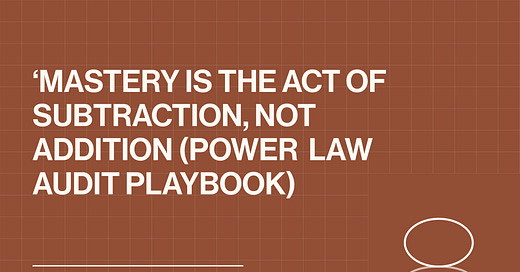🏴☠️ ⚡️'Mastery is the Act of Subtraction, not Addition' (Power Law Audit Playbook)
Join us every Saturday morning for deal analysis and diligence frameworks, value creation playbooks, operating concepts, and more...
TABLE OF CONTENTS:
Power Law Audit Framework
Execution Plan
Checklist
📺 WATCH:
📻 LISTEN:
In business, the default is to solve problems or seize opportunities with money and people (aka more). In nature, the default for growth and prosperity is essentially the opposite—first, prune the tree if you want it to grow.
Continuously hitting the ‘more button’ in business has harmful and unintended consequences in the long run: bloat and bureaucracy.
There are a few established laws and principles that help us understand this tendency:
Parkinson’s Law: Work expands to fill the time available for its completion.
Shirky Principle: Institutions will preserve the problem to which they are the solution.
Price’s Law: 50% of the productive work is done by the square root of the total number of people involved (e.g. in a team of 100 people, 10 of them are likely responsible for 50% of the output).
In our context (especially!), the tendency is to start with a “fix and add” mindset, which only exacerbates the accumulated inefficiency per the above. Instead, operators should adopt a “simplify and subtract” mindset out of the gates (and in the long run).
Or as my favorite philosopher, Bruce Lee, said…
[Mastery is] not the daily increase but daily decrease. Hack away the unessential.
To operationalize a “simplify and subtract” mindset, we utilize a Power Law Audit, which is highly effective as a one-time exercise (and should be revisited annually).
Let’s get to it!
POWER LAW AUDIT FRAMEWORK
The goal is to identify the 20% of activities, customers, and processes that generate 80% of the value and eliminate, delegate, or deprioritize the rest.
Step 1: Define and Measure Value
Core Metrics:
Revenue by customer, product, or service.
Gross margin per offering.
Operational efficiency metrics (e.g., cost-to-serve, response times).
Qualitative Value:
Strategic alignment with the business’s mission.
Long-term sustainability (e.g., subscription stickiness vs. one-time deals).
Step 2: Data Collection and Analysis
Customer Analysis:
Identify the top 20% of customers contributing to 80% of revenue.
Flag customers with disproportionately high support or acquisition costs.
Product/Feature Analysis:
Pinpoint products or features that drive the most revenue or customer satisfaction.
Identify low-value or legacy offerings that add complexity or distract resources.
Operational Workstreams:
Map internal processes and workflows.
Focus on activities that consume the most resources but yield minimal results.
Team and Resource Allocation:
Audit where time and effort are spent across teams (e.g., meetings, processes, firefighting).
Identify “power law performers” among employees or departments.
Step 3: Simplification Opportunities
Customer Pruning:
Let go of customers who cost more than they contribute (e.g., high support, low revenue).
Shift resources to high-value customers and upsell opportunities.
Product Rationalization:
Decommission low-value features or products.
Invest in improving the high-value offerings instead of adding new ones.
Process Streamlining:
Eliminate redundant or low-value processes.
Automate or delegate time-consuming tasks (e.g., reporting and approvals).
Team Simplification:
Reduce meeting time and decision-making layers.
Refocus the team on fewer, more impactful goals (e.g., OKRs).
EXECUTION PLAN (90-DAY)
Month 1: Deep Dive and Data Gathering
Customer Analysis:
Review customer-level financials and support data.
Conduct 1:1 conversations with top customers for qualitative insights.
Product and Revenue Review:
Analyze product-level revenue, gross margins, and usage metrics.
Identify underperforming or non-core offerings.
Team and Workflow Observations:
Conduct a team survey to identify the most time-intensive, low-value tasks
Observe recurring meetings and decision-making bottlenecks.
Focus on Simplification:
Identify 3-5 areas where subtraction could yield immediate clarity or resource savings.
Month 2: Prioritization and Simplification
Develop the Power Law Action Plan:
Identify 2-3 high-value initiatives to focus on (Power Law applies here just the same)
Outline simplification actions (e.g., decommissioning features, pivoting meetings to async).
Secure Alignment:
Share findings with the leadership team to ensure buy-in.
Involve team leads in identifying dependencies and risks for simplification actions.
Execute Quick Wins:
Address low-risk, high-impact areas first (e.g., eliminating a redundant feature, reducing meeting frequency).
Month 3: Implementation and Iteration
Start Implementation:
Begin executing simplification actions with clear timelines and accountability.
Monitor progress using pre-defined success metrics (e.g., revenue growth, efficiency gains).
Refine Focus Areas:
Use data from simplification efforts to refine the next set of priorities.
Begin shifting focus toward leveraging the simplified structure to scale high-value activities.
Communicate Results:
Share progress with the broader team to build momentum and reinforce focus on simplicity.
POWER LAW AUDIT CHECKLIST
WRAP UP
In business, the instinct to solve problems with "more"—more people, resources, or features—can lead to unintended consequences such as bloat, inefficiency, and bureaucracy. Nature offers a contrasting perspective: pruning fosters growth. Principles like Parkinson’s Law (work expands to fill the time available), Shirky’s Principle (institutions preserve the problems they solve), and Price’s Law (a small percentage of people generate the majority of output) highlight this tendency toward inefficiency.
Rather than defaulting to a “fix and add” mindset, leaders should adopt a “simplify and subtract” approach, which focuses on removing complexity and maximizing impact. The Power Law Audit operationalizes this by identifying the 20% of activities, customers, and processes that deliver 80% of the value, allowing businesses to eliminate or deprioritize the rest.
By following a structured framework for data collection, analysis, and prioritization—spanning customers, products, processes, and teams—leaders can uncover simplification opportunities, streamline workflows, and refocus resources on high-impact areas. This approach not only drives operational clarity but also sets a foundation for sustainable growth.
Hit REPLY and let me know what you found most useful this week (or rock the one-question survey below) — truly eager to hear from you…
And please forward this email to whoever might benefit (or use the link below) 🏴☠️ ⚡️




